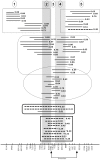Third chromosome candidate genes for conspecific sperm precedence between D. simulans and D. mauritiana
- PMID: 20388218
- PMCID: PMC2864193
- DOI: 10.1186/1471-2156-11-21
Third chromosome candidate genes for conspecific sperm precedence between D. simulans and D. mauritiana
Abstract
Background: Male - female incompatibilities can be critical in keeping species as separate and discrete units. Premating incompatibilities and postzygotic hybrid sterility/inviability have been widely studied as isolating barriers between species. In recent years, a number of studies have brought attention to postmating prezygotic barriers arising from male - male competition and male - female interactions. Yet little is known about the genetic basis of postmating prezygotic isolation barriers between species.
Results: Using D. simulans lines with mapped introgressions of D. mauritiana into their third chromosome, we find at least two D. mauritiana introgressions causing male breakdown in competitive paternity success. Eighty one genes within the mapped introgressed regions were identified as broad-sense candidates on the basis of male reproductive tract expression and male-related function. The list of candidates was narrowed down to five genes based on differences in male reproductive tract expression between D. simulans and D. mauritiana. Another ten genes were confirmed as candidates using evidence of adaptive gene coding sequence diversification in the D. simulans and/or D. mauritiana lineage. Our results show a complex genetic basis for conspecific sperm precedence, with evidence of gene interactions between at least two third chromosome loci. Pleiotropy is also evident from correlation between conspecific sperm precedence and female induced fecundity and the identification of candidate genes that might exert an effect through genetic conflict and immunity.
Conclusions: We identified at least two loci responsible for conspecific sperm precedence. A third of candidate genes within these two loci are located in the 89B cytogenetic position, highlighting a possible major role for this chromosome position during the evolution of species specific adaptations to postmating prezygotic reproductive challenges.
Figures



Similar articles
-
Positive selection at a seminal fluid gene within a QTL for conspecific sperm precedence.Genetica. 2014 Dec;142(6):537-43. doi: 10.1007/s10709-014-9800-7. Epub 2014 Nov 23. Genetica. 2014. PMID: 25417008
-
Quantitative trait loci for sexual isolation between Drosophila simulans and D. mauritiana.Genetics. 2004 Jul;167(3):1265-74. doi: 10.1534/genetics.103.024364. Genetics. 2004. PMID: 15280240 Free PMC article.
-
Mechanisms of conspecific sperm precedence in Drosophila.Evolution. 2000 Dec;54(6):2028-37. doi: 10.1111/j.0014-3820.2000.tb01246.x. Evolution. 2000. PMID: 11209779
-
Hybrid Sterility, Genetic Conflict and Complex Speciation: Lessons From the Drosophila simulans Clade Species.Front Genet. 2021 Jun 23;12:669045. doi: 10.3389/fgene.2021.669045. eCollection 2021. Front Genet. 2021. PMID: 34249091 Free PMC article. Review.
-
Sperm fate and function in reproductive isolation in Drosophila.Soc Reprod Fertil Suppl. 2007;65:155-73. Soc Reprod Fertil Suppl. 2007. PMID: 17644960 Review.
Cited by
-
Genetic Factors Influencing Sperm Competition.Front Genet. 2019 Sep 13;10:820. doi: 10.3389/fgene.2019.00820. eCollection 2019. Front Genet. 2019. PMID: 31572439 Free PMC article. Review.
-
Do candidate genes mediating conspecific sperm precedence affect sperm competitive ability within species? A test case in Drosophila.G3 (Bethesda). 2014 Jul 16;4(9):1701-7. doi: 10.1534/g3.114.012476. G3 (Bethesda). 2014. PMID: 25031180 Free PMC article.
-
Positive selection at a seminal fluid gene within a QTL for conspecific sperm precedence.Genetica. 2014 Dec;142(6):537-43. doi: 10.1007/s10709-014-9800-7. Epub 2014 Nov 23. Genetica. 2014. PMID: 25417008
-
Moving Speciation Genetics Forward: Modern Techniques Build on Foundational Studies in Drosophila.Genetics. 2017 Nov;207(3):825-842. doi: 10.1534/genetics.116.187120. Genetics. 2017. PMID: 29097397 Free PMC article. Review.
-
Expression of Mst89B and CG31287 is Needed for Effective Sperm Storage and Egg Fertilization in Drosophila.Cells. 2021 Feb 1;10(2):289. doi: 10.3390/cells10020289. Cells. 2021. PMID: 33535499 Free PMC article.
References
-
- Mayr E. Systematics and the Origin of Species. Columbia University Press, New York; 1942.
-
- Coyne JA, Orr HA. Speciation. Sinauer Associates, Sunderland MA; 2004.
Publication types
MeSH terms
LinkOut - more resources
Full Text Sources
Medical
Molecular Biology Databases

